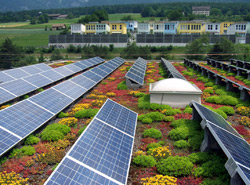Science teaches us not to answer questions in black and white terms—the meaning of data usually has many shades of gray. So it is with figuring out the micro and macro effects that different roof coverings might have on global warming or energy efficiency. The answers are starting to look more complex, and more promising, than ever.

For example, it would seem natural when studying rooftops and their effects on climate large and small to focus on extremes of albedo—in other words, black and white surfaces. This is sometimes the case in simplified modeling studies. But at this week’s AMS 9th Symposium on Urban Environment, in Keystone, Colorado, Adam Scherba of Portland State University submitted findings that moved beyond simple comparisons of white (“cool”) roofs versus black roof coverings. He and his colleagues mixed roof coverings, notably photovoltaic panels and greenery (which has the advantage of staying cooler during the day but not, like white roofs, getting much colder at night). The mix makes sense when you consider that roofs are also prime territory for harvesting solar energy. Scherba et al. write that
While addition of photovoltaic panels above a roof provides an obvious energy generation benefit, it is important to note that such systems – whether integrated into the building envelope, or mounted above the roof – can also result in an increase of convective heat flux into the urban environment. Our analysis shows that integration of green roofs with photovoltaic panels can partially offset this undesirable side effect, while producing additional benefits.
This neither-black-nor-white-nor-all-green approach to dealing with surface radiation makes sense from both energy and climate warming perspectives, especially given the low sun angles, cold nights, and snow cover in some climates. For instance, a recent paper, in Environmental Research Letters, uses global atmospheric modeling to estimate that boosting albedo by only 0.25 on roofs worldwide—in other words, not a fully “cool” scenario of all white (albedo: 1.0) roofs—can offset about a year’s worth of global carbon emissions.
And the authors of a recent modeling study (combining global and urban canyon simulation) published in Geophysical Research Letters simulated a world with all-white roofs but showed that:
Global space heating increased more than air conditioning decreased, suggesting that end-use energy costs must be considered in evaluating the benefits of white roofs.
Delving directly into such costs this week at the AMS meeting is a paper from a team led by Anthony Dominguez of the University of California-San Diego. They looked at the effects of photovoltaic panels on the energy needs in the structure below the roof, not the atmosphere above it.
Did they find that a building is easier to keep comfortable when covered by solar panels? Well, if you need to air-condition during the day, yes. If, however, like many people on the East Coast this summer, you need to keep cooling at night, then no. This is science—don’t expect a black-and-white answer.